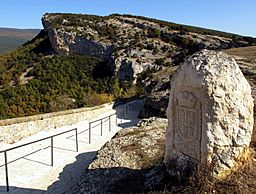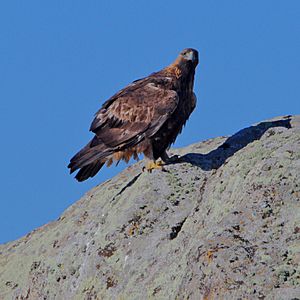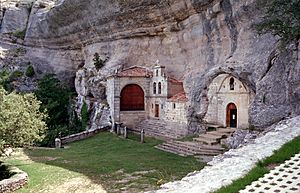Ojo Guareña facts for kids
Quick facts for kids Ojo Guareña |
|
|---|---|

Site of the natural monument of Ojo Guareña
|
|
| Location | Province of Burgos, Spain |
| Geology | Coniacian limestone |
| Entrances | 10 |
Ojo Guareña is an amazing karst complex (a type of landscape with caves and sinkholes) located in northern Spain. It's found in the Cantabrian Mountains of Castile and Leon. In 1996, the government of Castile and Leon declared it a natural monument, meaning it's a special protected area.
This huge cave system has more than 90 kilometres (56 mi) of tunnels and rooms. It covers an area of about 13,850 hectares (34,200 acres). The caves formed in limestone rock, which is about 100 metres (330 ft) thick. This rock sits on a layer of marl, which doesn't let water through. The caves were carved out by erosion during the Coniacian Age, a long time ago.
For many years, Ojo Guareña was thought to be the biggest karst system in the Iberian Peninsula. However, in 2009, new passages were found in the Mortillano system, making it even longer.
Scientists have found signs that humans used these caves from the Middle Palaeolithic period all the way up to the Middle Ages. They have also discovered over 180 different kinds of invertebrates (animals without backbones) living inside the complex.
You can visit parts of the Ojo Guareña caves. There's a special visitor's center in Quintanilla del Rebollar where you can learn more.
Contents
Features of the Cave System
The Ojo Guareña karst complex is a giant network of tunnels and open spaces. Not all of these parts are connected. The main network includes fourteen caves that link up with each other on six different levels. The easiest way to enter is through Palomera Cave.
The caves were formed by the powerful erosion of the Guareña and Trema rivers, along with the Villamartín stream. These rivers flow through the lower tunnels for most of the year. During times of heavy rain, the water can even reach the higher tunnels.
Eventually, the water comes out of the ground through karst springs. These springs are located at Trema, Torquilla, Torcón, and Torcona, further down the Trema River. The underground water moves through Ojo Guareña at a speed of 1.5 to 5 kilometers (about 1 to 3 miles) per day. This speed changes depending on whether it's the dry summer or the rainy season. This groundwater also helps to fill an aquifer (an underground layer of water-bearing rock).
Animals and Plants

Many birds live around the cave complex. These include large birds like the golden eagle, short-toed snake eagle, and Egyptian vulture. You might also spot Eurasian sparrowhawks, Eurasian eagle-owls, griffon vultures, tawny owls, and peregrine falcons.
Inside the caves, several types of bats make their homes. These include the cave bat, greater horseshoe bat, lesser horseshoe bat, and Geoffroy's bat. Other mammals in the area are the Pyrenean desman (a small, water-loving animal), the wildcat, the dormouse, and the Eurasian otter.
In 2012, scientists reported finding 187 different invertebrate species in Ojo Guareña. These creatures belong to many different groups. Amazingly, 32 of these species had never been seen by scientists before! Out of more than 200 known cave-dwelling aquatic invertebrates in Spain, over a quarter of them were found right here in Ojo Guareña.
The plants around Ojo Guareña are very diverse. This is because the area is a meeting point between the Mediterranean and Euro-siberian climate zones. The land is covered with meadows, grasslands, heathlands, and Iberian forests. You can find many kinds of trees, such as different types of oak, beech, hazel, poplar, alder, pine, and aspen.
Discoveries from the Past
Archaeologists have found clear signs that people lived in and around the Ojo Guareña caves for a very long time. This goes from at least the Middle Palaeolithic period up to the Middle Ages.
Stone Age Discoveries
The oldest evidence of humans, like cave paintings and tools, was found in the Prado Vargas cave. In 1973, archaeologists found pieces of ancient pottery. Later, in 1986, more pottery and stone tools were discovered. These tools suggested that Neanderthals might have lived there.
In 2006, about 400 Mousterian pieces (a type of stone tool) were found. This site was then called an archaeological industry. Scientists also found footprints from people making a round trip, along with pieces of torches. These torch pieces have been radiocarbon dated to be as old as 15,600 years! This shows that the cave has been used for thousands of years.
Later Stone Age and Bronze Age
In the Cave of Kaite, paintings have been found that seem to show deer. On the walls and ceiling of the Sala de la Fuente (Fountain Room), there are paintings of people, animals, and geometric shapes. These images were made over a long period, from the late Neolithic (New Stone Age) to the beginning of the Bronze Age.
Protected Status
Ojo Guareña is a very important natural area. On March 14, 1996, it was officially declared a Natural Monument of Ojo Guareña. This means it is protected by law. There is also a special board that helps manage and protect this amazing place.
See also
 In Spanish: Ojo Guareña para niños
In Spanish: Ojo Guareña para niños
- List of longest caves



